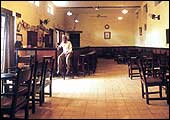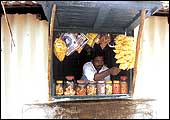 |
| The silent mines of Kolar Gold Fields |
Robertsonpet
Shigmani Devraj, 54, is overcome with emotion as he talks of the
days he spends doing nothing. It's been nearly 11 months since he
donned his miner's helmet, got on a creaky elevator and descended
nearly a mile under the earth. This is all he did for 36 years.
This is all he knows. ''We do not know what to do now,'' says Devraj
wearily as he sits on a cardboard box that is the main seating in
his ancestral ''house''-a zinc-roofed small room that's partitioned
into two by a dirty, cotton curtain. This is where his father stayed.
And his father.
Yet, he cannot call this shanty-official quarters
for nearly 11,000 miners-home. Devraj's shoebox home, like almost
everything in this mining town, is owned by the Bharat Gold Mines
Ltd (BGMl). Once known as the home of Champion Reef, the deepest
mine shaft in the world, the town is called Kolar Gold Fields (kgf).
It's just 72 km east of Bangalore, but the distance to the new India
from this dying outpost of a past industrial era seems unbridgeable.
| Death Of A Company Town |
 |
| FAILED: A desperate management tried, unsuccessfully,
to manufacture railway wagons to stay afloat |
 |
| EMPTY: The brass fittings, imported silver cutlery,
and the people, have disappeared from Kolar Club |
 |
| ENDGAME: His livelihood gone forever, former
miner Muniswamy is teaching himself to run a petty shop |
When KGF officially shut down on March 1, 2001,
it didn't just end a legacy of three, sometimes four, generations
and throw thousands of miners out of work. It sounded the death
knell of a town of 1.5 lakh, an economy that grew around the gold
fields, and a way of life that's flourished since a retired British
army officer sunk the first mine shaft in 1875. ''The curse of the
gold has befallen us,'' says a grim Antony Raj, 43. ''Our forefathers
came to work these mines to escape poverty, but we are back to where
they began-in abject poverty.'' Mostly semi-literate Tamilians and
some Telugus, the miners numbered 32,000 during the Second World
War.
As the town blossomed at the turn of the last
century, it was a beacon for this part of the southern hinterland.
''A general rush was made for gold,'' notes the Gazetteer of 1905.
In 1902, it was the first Indian town to get hydroelectricity. It
was the first to get its own railway branch line. In what was a
desolate wasteland, there arose a town with its own schools, gracious
bungalows, a hospital, and a sprawling 110-year-old clubhouse-its
roof now punctured, its halls silent. There's even a golf course,
overrun by weeds. And the hospital is closed.
The golden era doesn't seem that distant. Until
last year, more than Rs 40,000 crore worth of gold had been extracted
from this celebrated lode. Today, with accumulated losses of Rs
560 crore, it's hard to imagine the mines once contributed one-third
of the revenues to the erstwhile Mysore state. With KGF regarded
as an insignificant Tamil corner of modern Karnataka, no politician
really cares. KGF's fate was inevitable. The mines were never profitable
after nationalisation in 1956-by then 90 per cent of its easily
reachable gold had been removed. bgml made profits only for three
years, from 1979 to 1981, and only because of a spurt in international
gold prices. In 1992, it was referred to the Board of Industrial
Finance and Reconstruction, which recommended closure. Two VRS schemes
have cut its workforce to 90 officers and 3,410 miners. With court
battles underway-18 obdurate unions either demand that the mines
be revived or they be paid high compensations, while the management
believes all options have been exhausted-no salaries have been paid
for 11 months.
It's not like there's no gold left in KGF. It's
just too deep and difficult to remove. The market price for 10 grams
of gold is around Rs 4,500, but the cost of extracting the same
amount of KGF gold is Rs 22,000. In the glory days, every tonne
of ore yielded 45 grams of gold. Today, you might get two grams.
|
TREADMILL
|
| Rewind With Dave Draper
Tuna and water. Yes, that's
what you ought to be eating right now. Six small meals a day.
Tins of tuna and litres of water. It's a high protein, negligible
fat schedule advised for a post-holiday season clean-up. The
diet goes like this. For three straight days, you eat nothing
but tuna and water. Okay, you can add a bit of low fat cottage
cheese or a dash of Tabasco and fresh squeezed lemon juice.
But stick to the tuna and water.
Strange advice? But it comes from one great dude. Heard
of Dave Draper? Draper is a former Mr America, Mr Universe,
Mr World, and a fixture on covers of fitness magazines through
the 1960s and 70s. Currently 59, Draper's schedules have largely
remained unchanged. If you want to see how he looks like,
check out www.davedraper.com. Draper's IronOnline gets 5,000
visitors a day. And his weekly e-newsletter, Draper Here...
has thousands of fans.
Last week, Draper talked about the T&W diet. Here's
an extract: For those in the dark, the rather entertaining
and fulfilling scheme goes like this: You are going to eat
tuna and water for three straight days. Choose your starting
day. Psyche up. You'll be consuming water by the jugs-at least
two quarts a day-and one to one-and-a-half grams of protein
per pound of bodyweight in six equal servings throughout the
day. Back this with your vitamins and minerals morning and
night, eight capsules of branch-chain amino acids (key muscle
building protein) before and after your workouts and a nightly
portion of Metamucil for fiber. Sitting in a lotus position
and inhaling through the nostrils and exhaling through the
mouth is optional.
Forget the 'Metamucil' and the 'branch-chain amino acid'
bit. For it's probably not wrong to assume that very few of
BT's readers are going enter a body-building contest anytime
soon! But the tuna-and-water deal makes sense. Tuna and water,
says Draper, is a sort of atonement for sins committed. A
cleansing. Its ingredients serve to drop the carbohydrate
and fat calories, while maintaining the protein. In Draper's
words it (allows) the hormones and the enzymes to settle down
and generally rid the mind and body of the noise, clutter
and clatter-the kaleidoscope of food, food and food...Its
simplicity and absurdities are attractive.
That's Draper for you. Seldom has a fitness or bodybuilding
expert written with such felicity and passion. As for the
tuna and water diet, no I haven't tried it. But I do read
Draper Here... every week. It helps gets my butt back to the
gym every Monday morning!
Muscles Mani
|
Life Comes A Full, Miserable, circle
The closure of KGF left thousands unprepared
for a life without the mines. Their severance package was simple:
45 days of pay for every year of service. Miner Devraj admits much
of it was used to repay old debts, marry daughters, or simply drunk
away. The evening tipple was always a part of the miner's life,
a fallout of the hot, hard hours underground.
''We have tried our utmost to help the workers,''
says S. Sampath Kumar, 45, Manager (Engineering services), in charge
of BGML in the absence of CMD S.D. Prasad, who officiates from his
office-in New Delhi. Kumar says some were deployed to coal mines
as far afield as Bihar and Jharkhand, but every Indian mine is overstaffed.
BGML even tried its hand at making railway wagons, but unsurprisingly,
it didn't work.
The miners are slipping back to the subsistence
economy of their forefathers. The subsidised canteen is gone. Their
wives wash clothes on the roads since subsidised power and electricity
has been discontinued to 11,000 homes. KGF's trees, lovingly planted
by the town's founders, are being chopped up for firewood-the latest
blow in a town ravaged by the downside of mining. Water bodies have
silted up and coconut trees have withered under a thick blanket
of dust. Mine waste occupies 15 per cent of the town's land.
Antony Raj, 51, says the dying town just doesn't
have a job for old miners like him. ''All we know is physical labour;
with the construction sector down, who will employ us?" At
the local India Full Gospel Fellowship Church, the pastor, Rev.
Monovah Nickelson, 46, spends most of his time with relief work.
''The financial aspect of the problem reflects just one perspective,''
says Rev Nickelson. ''It is the emotional trauma, a sense of being
abandoned by the State that is causing the most damage.'' With dismay,
he reports an increased in theft, prostitution, alcoholism and a
rise in suicides in his old town.
Yet, there are a handful who are scratching
together a new life. Some raise poultry, others run tailoring shops,
saloons, and grocery stalls. But these are only holding operations.
No entrepreneurship can bloom since the town's land is literally
owned by BGML. To set up anything is to run a daunting bureaucratic
gauntlet.
So miner Yesudasan, 47, morphed into an electrician.
He earns Rs 200 daily and has got his son to ply an autorickshaw
after getting a bank loan. ''I decided to take the VRS scheme,''
says Yesudasan. But there is little business for him in a dying
town. He commutes to Bangalore to offer his services as an itinerant
electrician. The mines, Yesudasan knows, will never open again.
|

